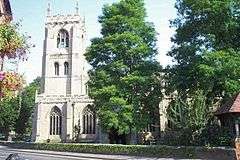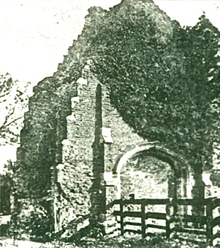Kirton, Lincolnshire
Kirton, or Kirton in Holland, is an English village and civil parish within the Borough of Boston, in Lincolnshire. The population of the civil parish at the 2011 census was 5,371.[1]
| Kirton | |
|---|---|
 Church of St Peter and St Paul, Kirton | |
 Kirton Location within Lincolnshire | |
| Population | 5,371 |
| OS grid reference | TF304385 |
| • London | 100 mi (160 km) S |
| District |
|
| Shire county | |
| Region | |
| Country | England |
| Sovereign state | United Kingdom |
| Post town | BOSTON |
| Postcode district | PE20 |
| Dialling code | 01205 |
| Police | Lincolnshire |
| Fire | Lincolnshire |
| Ambulance | East Midlands |
| UK Parliament | |
History
Kirton was the seat of Lincolnshire's first Saxon kings, later becoming a market town.[2]
In the Domesday account the village is written as “Cherchetune”. It consisted of 52 households, with 30 freemen and 16 smallholders, 12 ploughlands, 10 plough teams, a meadow of 60 acres (0.24 km2), a church and two salt houses. In 1066 lordship of the manor was held by Earl Ralph, being transferred to Count Alan of Brittany in 1086.[3][4]
Before the local-government changes of the late 20th century, the parish had formed part of Boston Rural District, in the Parts of Holland. Holland was one of the three divisions (formally known as parts) of the historic county of Lincolnshire. After the Local Government Act of 1888, Holland was in most respects a county in itself.
In 1885 Kelly's Directory recorded Kirton as having a railway station on the Great Northern Railway. This closed in 1961.
There existed Congregational and Wesleyan chapels and almshouses for four poor women. The village market was then disused. The Gas Consumers' Company Ltd was formed here in 1865. Principal landowners were The Mercers' Company, Sir Thomas Whichcote DL, E. R. C. Cust DL, the Very Rev. Arthur Percival Purey-Cust DD, and Samuel Smeeton, whose residence was the "modern white building" of D'Eyncourt Hall. Agricultural production within the 8,962 acres (36.27 km2) parish consisted of wheat, beans and potatoes, and there was a "large quantity of pasture land" and 676 acres (2.74 km2) of marsh land. The 1881 the ecclesiastical parish population was 2,011, the civil parish, 2,580.[5]
Church
The parish church is dedicated to St Peter and St Paul.[6] The transepts had double aisles like those of Algarkirk[7] and Spalding,[8] but in 1804 the central tower and transepts were pulled down and the chancel shortened, the architect (Hayward) using gunpowder to remove the tower. Rebuilding was completed by 1809. In 1900 a restoration of the church was undertaken by the architect Hodgson Fowler.[9]
Grammar school
In 1624 Thomas (later Sir Thomas) Middlecott was empowered by a Private Act of Parliament to found a Free Grammar School for the instruction of the Latin and Greek languages, and English commercial and agricultural education, to children from the parishes of Kirton, Sutterton, Algarkirk and Fosdyke. By 1835 the school had 40 pupils, partly free and partly fee-paying. The Master (headmaster) appointed in 1773, Rev. Charles Wildbore (c. 1736–1802), and later his son by the same name (1767–1842), were alleged to have diverted surplus income from the school's endowments for their own use, and failed to maintain educational standards. This culminated in a parliamentary report, and the management of the school was ultimately restructured in 1851. By 1885, William Cochran was Master, and a new school house had been erected adjacent to his residence. Under a scheme of the Endowed School Act, amended in 1898, the school was ranked as a "second-grade" Grammar School.[5][9][10][11]
In the 1830s a girls' school for 14 day and boarding pupils, and a Sunday School for 32 males and 16 females existed in the village.[11]
The village now has a secondary modern school: Thomas Middlecott Academy.
The Old King's Head
The Old King's Head is a former public house listed as a Grade II historic building. The earlier part of it was built at the end of the 16th century. It underwent major alterations in 1661 in Artisan Mannerist Style. It is red brick in English bond, with recent tiles on a former thatched roof. It became a domestic residence in the 1960s, but had fallen into disrepair and was purchased in 2016 by Heritage Lincolnshire, which has assigned over £2 million for its restoration.[12]
Geography
Kirton is on the A16, B1397 and B1192 south of Boston, near Frampton and Sutterton. Several satellite villages and hamlets take their name from Kirton, including Kirton Holme, Kirton End, Kirton Fen, Kirton Skeldyke, and Kirton Marsh. Until 1970, the village had the Kirton railway station.
Kirton Meres

The parish contained the ancient manor of Kirton Meres, the seat of Roger de Kirton (d.1383) (alias de Kirketon / Roger de Meres / Meeres), a Justice of the Common Pleas (1371–80).[13] The manor house (later known as "Orme Hall"[14]) was demolished in 1818 but the arched gatehouse (Porter's Lodge, built of brick, guard room, and chambers over it, with stone dressings, windows, archway, door-ways, and copings, surmounted by highly pitched step gables, with 15 sculpted heraldic shields, some now held by the Spalding Gentlemen's Society, Broad St, Spalding, Lincs) survived until 1925 on the south side of the Willington Road, one mile west of the village of Kirton. Another of this family resident at Kirton Meres was the churchman Francis Meres (1565-1647).[15]
Local governance
Local governance of the village was reorganised on 1 April 1974, as a result of the Local Government Act 1972. Kirton parish forms its own electoral ward.
Kirton falls within the drainage area of the Black Sluice Internal Drainage Board.[16]
Research centre
The former Kirton Research Centre was nearby. Ownership of the 120-acre (0.49 km2) centre for horticultural research was transferred from the Department for Environment, Food and Rural Affairs to the University of Warwick in April 2004 and it became part of Horticulture Research International. In August 2009 the University closed it, as public and private funding fell £2 million short of covering its annual running costs.[17]
Notable people
In order of birth:
- Francis Meres (1565 or 1566–1647), churchman and author[18]
- Joseph Gilbert (1732–1821), born in Kirton, was Master of HMS Resolution on Cook's second voyage.
- Sarah Swift (1854–1937), born in Kirton Skeldyke, set up the Royal College of Nursing.
- Harold Jackson VC, (31 May 1892 – 24 August 1918), a sergeant in The East Yorkshire Regiment who received the Victoria Cross in 1917 and was killed a year later, came from Allandale, Kirton.
- Oliver Ryan (Ollie Ryan, born 1985), footballer, attended Kirton Primary School.
See also
- Attorney General v Davy (1741) 26 ER 531, a leading legal case in UK company law
References
- "Civil Parish population 2011". Neighbourhood Statistics. Office for National Statistics. Retrieved 21 May 2016.
- Kirton in Holland, Genuki.org.uk. Retrieved 23 April 2011.
- "Kirton" Archived 28 July 2012 at Archive.today, Domesdaymap.co.uk. Retrieved 20 April 2012.
- "Documents Online: Kirton, Lincolnshire", Folio: 367v, Great Domesday Book; The National Archives. Retrieved 20 April 2012.
- Kelly's Directory of Lincolnshire with the port of Hull 1885, pp. 504–505.
- St.Peter & St.Paul's church geograph.org.uk; retrieved 23 April 2011.
- St.Peter & St.Paul's church, Algakirk, Lincs geograph.org.uk; retrieved 23 April 2011.
- The Church of St Mary and St Nicolas, Spalding geograph.org.uk; retrieved 23 April 2011.
- Cox, J. Charles (1916); Lincolnshire p. 187; Methuen & Co. Ltd.; retrieved 23 April 2011.
- Report of the commissioners appointed in pursuance of an act of Parliament made and passed in the 5th and 6th years of King William the 4th, c. 71, intituled, "an act for appointing commissioners to continue the inquiries concerning charities in England and Wales, until the first day of March one thousand eight hundred and thirty-seven"; P. P. 1839 [194] 32 – Part IV, 38.
- Great Britain. Parliament. House of Commons (1835); Parliamentary Papers, Volume 42, p. 527; BiblioBazaar, LLC (2010). ISBN 1144191092.
- The Old King's Head gets a new lease of Life.
- Sainty, John, The Judges of England 1272 -1990: a list of judges of the superior courts, Oxford, 1993, p.66; Foss, Judges of England: "Roger de Meres was of a Lincolnshire family, established at Kirketon in the district of Holland"; Edward Deacon, The descent of the family of Deacon of Elstowe and London, with some genealogical, biographical and topographical notes, and sketches of allied families including Reynes of Clifton, and Meres of Kirton, p.18
- Earliest mention of "Orme Hall" in Marrat's "History of Lincolnshire", 1814
- Kirton, Jonathan G., The Ruin at Kirton, 2013 ; Article by Colonel C. T. J. Moore, "Lincolnshire Notes and Queries", Vol. III, (1893), Item 140, on pages 243 and 244; "Notes and Queries", 8th. Series, Volume XII, July to December 1897, page 47, 17 July 1897; "Oxford Journals", "Notes and Queries", 9th. Series, Volume IV, July to December, 1899, Page 229 (dated Sept. 16, 1899)
- "Black Sluice IDB".
- The Kirton Research Centre, University of Warwick.
- "Meares, Francis (MRS584F)". A Cambridge Alumni Database. University of Cambridge.
External links
| Wikimedia Commons has media related to Kirton, Lincolnshire. |